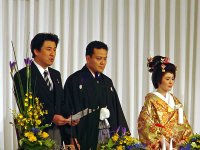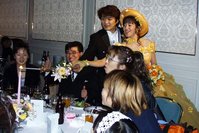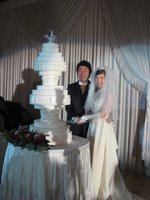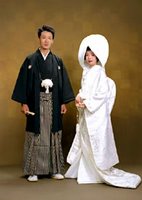
This is the second part of my presentation☆☆
Let’s go through the history of Japanese weddings. Until the end of the 19th century, we didn’t have particular wedding styles. When a couple got married, the families, relatives, and neighbors got together at a bride or groom’s house, the couple announced their marriage, and they had an informal party. There was no formal ceremony, and the party was not organized. I think we can call it an “Intimate style(人前式)” wedding. The interesting thing is an intimate style wedding is now getting popular again in Japan, and many young people think this is the latest style when they compare it to the Shinto, Buddhist, or Christian styles. However, it was a very traditional Japanese wedding style.
The first influential Japanese wedding was the Taisho emperor’s wedding in 1900. At that time, he was a prince. The prince and princess went to a Shinto shrine wearing beautiful Kimonos, and celebrated their wedding. Many newspapers showed the pictures, and many Japanese were fascinated by their style. Since the price's wedding, the Shinto style (神前式)wedding became popular.
However, in 1914, World War 1 started. In 1939, World War 2 began and in 1945, Japan lost the war. During the chaotic ages between the wars, people couldn’t afford to have formal weddings.
But, from the 1950’s to the 1970’s, the Japanese economy had been getting very strong. The economic growth rate increased more than10 % annually in this era. The Japanese life had been changing dramatically. In the 1950’s, many hotels started wedding businesses. They built wedding facilities like Shinto wedding rooms, banquet rooms, and advertised gorgeous weddings. Also, a wedding complex (結婚式場)style emerged. A wedding complex is like a small theme park of weddings. The first picture is the a
 ppearance of a wedding complex. (The first three pictures are from the Website of the biggest Japanese wedding complex company. http://www.nagasaki-heiankaku.jp/ ) A huge building. A wedding complex has a Japanese Shinto wedding room, a Buddhist wedding room, a chapel, and some banquet facilities that have different capacities. In some local areas, a wedding complex style is still popular because it is convenient! You can choose any style of ceremonies, and you don’t have to move to a reception place.
ppearance of a wedding complex. (The first three pictures are from the Website of the biggest Japanese wedding complex company. http://www.nagasaki-heiankaku.jp/ ) A huge building. A wedding complex has a Japanese Shinto wedding room, a Buddhist wedding room, a chapel, and some banquet facilities that have different capacities. In some local areas, a wedding complex style is still popular because it is convenient! You can choose any style of ceremonies, and you don’t have to move to a reception place. It might be funny to you that most wedding complex companies have funeral complexes(葬儀場). Because
 Japanese thought weddings and funerals were formal occasions, we thought they were in the same category. (冠婚葬祭) When I worked as a wedding emcee, one day, one guy came close to me and said, “You are very lucky to be “a wedding” emcee.” I asked “why?” and he answered, “Because I am a funeral emcee.” It is true, but nowadays, we think it is weird and an old-fashioned concept. Therefore, we insist we are involved in a “ wedding” business, not “weddings and funerals!”
Japanese thought weddings and funerals were formal occasions, we thought they were in the same category. (冠婚葬祭) When I worked as a wedding emcee, one day, one guy came close to me and said, “You are very lucky to be “a wedding” emcee.” I asked “why?” and he answered, “Because I am a funeral emcee.” It is true, but nowadays, we think it is weird and an old-fashioned concept. Therefore, we insist we are involved in a “ wedding” business, not “weddings and funerals!”Let’s go back to the history of Japanese weddings. The era of the 1950’s to 1970’s is called “ the period of high economic growth.”(高度成長期) I think the slogan of this era was “Keep up with the Joneses!” People tried to follow what their rich neighbors or friends were doing because they wanted to look rich or gorgeous. Before that, a wedding reception was informal and guests were families and relatives. However, it became more organized and the bigger a party became, the more guests arrived. Couples started to invite friends, their bosses, and colleagues. Actually, the groom’s boss had a significant role in the wedding in this era. He would be a “wedding matchmaker”(媒酌人) which is a Japanese characteristic of weddings. Originally, a matchmaker is the person who tries to find the right partner for someone else to marry. However, a Japanese wedding matchmaker doesn’t have to be the one who introduced a bride to a gro
 om. He is a symbolic matchmaker. Here are some wedding matchmakers’ pictures. These wedding matchmaker's pictures are from http://kiharaminoru.jp/modules/blog/category/category-1/The first guy is a captain of this reception, so he works at the place, and is not a guest. The second guy is a wedding matchmaker, and he is the groom’s boss. This is a groom. This lady is the matchm
om. He is a symbolic matchmaker. Here are some wedding matchmakers’ pictures. These wedding matchmaker's pictures are from http://kiharaminoru.jp/modules/blog/category/category-1/The first guy is a captain of this reception, so he works at the place, and is not a guest. The second guy is a wedding matchmaker, and he is the groom’s boss. This is a groom. This lady is the matchm aker’s wife. The bride follows the matchmaker’s wife.
aker’s wife. The bride follows the matchmaker’s wife. Here is (the left one)a picture during the reception. The left one is the matchmaker. He is making a speech. The matchmaker is always beside the groom. She doesn’t appear in this picture, but the matchmaker’s wife is always beside the bride. As you can see, the matchmaker is very important, and outstanding in a wedding reception. Therefore, believe it or not, some business people say your official future would change depending on which boss you ask as your wedding matchmaker. Now, we have figured out Japanese weddings became very official in this era. In the 1960’s, couples started to ask professional emcees to organize their weddings because wedding receptions became ceremonial. It is funny to me that the pioneer of the Japanese emcee was...寿 太郎, whose name is translated "Celebrate Tom!"

From 1970’s to 1980’s, people preferred more gorgeous weddings. This (the right picture) is called a “candle service.” (This picture is from http://www.joho-kyoto.or.jp/~lions/naitou/p4.html ) The bride and groom hold
 a candle together and light the tables’ candle, and then, they light a big, gorgeous main candle. (The left picture is from http://www.ne.jp/asahi/tsuru/kendo/2003-0720-11.jpg)They cut the wedding cake together as a ceremony. ( This picture is from http://sergeant.main.jp/ ) The cake had to be very tall, and big enough that every guest could see. But those wedding cakes were fak
a candle together and light the tables’ candle, and then, they light a big, gorgeous main candle. (The left picture is from http://www.ne.jp/asahi/tsuru/kendo/2003-0720-11.jpg)They cut the wedding cake together as a ceremony. ( This picture is from http://sergeant.main.jp/ ) The cake had to be very tall, and big enough that every guest could see. But those wedding cakes were fak e cakes because real cakes couldn’t stand this height. Some couples appeared riding in a gondola from the ceiling, and some of them appeared from the dry ice. I heard an American guest said, “A Japanese wedding is like a Las Vegas show.”
e cakes because real cakes couldn’t stand this height. Some couples appeared riding in a gondola from the ceiling, and some of them appeared from the dry ice. I heard an American guest said, “A Japanese wedding is like a Las Vegas show.”In this era. Especially, they paid much for the brides’ costumes. The typical bride celebrated her wedding ceremony in the Shinto style with a white Kimono(like the first left picture in the row is from http://www.matsui-studio.com/konrei/konrei.htm )and she appeared at her reception wearing a colored Kimono( The middle picture under the row is from http://homepage2.nifty.com/takahiro-masumi/maedori.htm. )But during the reception, she changed her costume twice to wear a wedding gown and a colored evening dress. (The right picture in the row is from http://www.center.nitech.ac.jp/~kenji/Diary/020428-wedding/photo.html The left picture under the row is from http://stevie.ti-da.net/e767771.html)

Actually, this style

 of wedding still remains in some areas. I had been to this traditional
of wedding still remains in some areas. I had been to this traditional type of weddings in my hometown, Sapporo before I got married. I usually did some performances like singing a song, or a short play with my friends. However, the brides never saw our performances because they were very busy changing their clothes!
type of weddings in my hometown, Sapporo before I got married. I usually did some performances like singing a song, or a short play with my friends. However, the brides never saw our performances because they were very busy changing their clothes!
In 1981, one worldwide celebrity got married. She was Princess Diana, in England. (Her picture is from http://chiba.cool.ne.jp/koichi76/subj16.htm ) She was very po pular in Japan. After her wedding was broadcast, many Japanese girls contacted domestic and international churches to ask if they could celebrate their weddings like Diana’s style. Before one year, in 1980, A Japanese true star in the era, Momoe Yamaguchi, a singer, got
pular in Japan. After her wedding was broadcast, many Japanese girls contacted domestic and international churches to ask if they could celebrate their weddings like Diana’s style. Before one year, in 1980, A Japanese true star in the era, Momoe Yamaguchi, a singer, got  married to Tomokazu Miura, a famous actor, as a Christian style. (Her picture is left. It is from http://plaza.rakuten.co.jp/vegatta/ ) Many hotels and wedding complexes started to have “wedding chapels” in this era. This Christian style ceremony has become the most popular one even now instead of the Shinto style.
married to Tomokazu Miura, a famous actor, as a Christian style. (Her picture is left. It is from http://plaza.rakuten.co.jp/vegatta/ ) Many hotels and wedding complexes started to have “wedding chapels” in this era. This Christian style ceremony has become the most popular one even now instead of the Shinto style.
Let’s review the traditional Japanese weddings until the 1980’s. I would say, the keywords of traditional weddings are formal, polite, and conservative. The couples invited many guests including their bosses, so they had to be polite, and the wedding was considered as a very formal occasion. Also, many people followed the routine wedding styles by having matchmakers, wedding cakes, and candle services. Everybody could expect what would happen next. In addition, most couples took ceremony styles such as the Shinto style or Christian style not because of their religion, but their preferences.
In the 1990’s, the Japanese economy worsened. Before that, the Japanese economy was called “the bubble economy.” Literally, the bubble burst. The estate value decreased, and many business people’s salaries were frozen. People started to wonder why we had to pay so much money for weddings. Therefore, the “simplest wedding” came to be noticed. It means a newlywed registered their marriage, but they didn’t have a special ceremony and reception. However, it is always a girl’s dream to wear a wedding gown. Also, most parents dream of their daughters’ most beautiful event. But, no more old formal styles! From the late 1990’s, young people started to seek their “original” weddings. Now, let’s move on to the Japanese modern weddings! Are you ready? My presentation goes on FOREVER!!!
2 comments:
Liz!
I know you love Kimonos! They are not practical clothes at all! Heavy, difficult to move...but I am glad you feel the Japanese traditional beauty sense☆
Thank you for posting such a great blog. I found your website perfect for my needs. Read About Bilingual MC Wedding Atlanta
Post a Comment